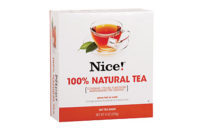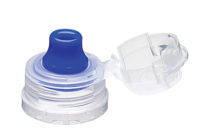These days, consumers have a plethora of choices to make while they’re shopping for beverages. Besides the flavor, brand or product type, they’re bombarded with statements like “low sodium,” “low calorie,” “natural” and “organic.”
According to “Natural and Organic Foods and Beverages in the U.S., 3rd Edition,” from market research publisher Packaged Facts, New York,
37 percent of U.S. adults buy organic groceries and 56 percent of U.S. adults buy packaged food products marketed as “all natural.”
Mass market retailers, including conventional supermarkets, drug stores and mass merchandisers, will capture almost half of dollar sales of natural and organic foods and beverages in 2011, the report states. The natural foods channel, however, isn’t far behind. Packaged Facts estimates that it will capture a 38 percent share this year.
“Natural foods outlets appear to be attracting a much wider range of shoppers than ever before,” says Jon Hauptman, partner at Willard Bishop LLC, Barrington, Ill. “Most shoppers, regardless of income, education or geography, are interested in providing the freshest, healthiest meals for their families that they can, and they’re increasingly shopping a broader spectrum of stores looking for healthful options. In this day and age, shoppers recognize that they must take greater control over their families’ health and wellness, and natural foods stores provide products, information and services to help them do just that.”
Sales for natural and organic foods and beverages rose significantly during the last few years. From 2005 to 2010, sales increased 63 percent, Packaged Facts reports. From 2009 to 2010, U.S. retail sales of natural and organic foods and beverages rose 9 percent to nearly $39 billion, it adds.
Packaged Facts projects that sales will increase 45 percent by the end of this year. Furthermore, it predicts that the market will grow 103 percent between 2010 and 2015, with total annual sales exceeding $78 billion in 2015.
Going mainstream
The success of natural and organic products and stores has led other retail channels and large consumer packaged goods (CPG) companies to consider getting healthier. Many traditional grocery stores have dedicated sections of their stores to natural and organic products.
“Grocery chains from Harris Teeter to Walmart have added large organic produce sections, amped up the number of locally grown products they offer, and added store brand natural and organic items,” wrote Sue Stock, staff writer for newsobserver.com, in an article published March 16. “Harris Teeter now carries nearly 800 organic items and claims to have seen ‘substantial growth’ in organic sales over the past few years.”
Likewise, CPG companies such as Coca-Cola, Atlanta, and PepsiCo, Purchase, N.Y., are putting more of a focus on natural offerings.
In March 2011, The Coca-Cola Co. purchased Bethesda, Md.-based Honest Tea, completing a transaction that began in 2008 when Coca-Cola took a 40 percent stake in the organic beverage company. Both companies see the deal as an opportunity to mainstream organic beverages, the Packaged Facts report states.
“As we’ve toiled away for the past 13 years [since the company’s founding], two exciting things have happened,” said Seth Goldman, co-founder, president and TeaEO of Honest Tea, in a video message posted on the company’s website. “First, American consumers have really started to pay attention to what they put in their body. And, the big food and beverage companies have started to recognize the need for a broader portfolio of drinks for their consumers.”
In September 2010, PepsiCo replaced its Sierra Mist brand with Sierra Mist Natural, a soft drink made with five ingredients. It contains real sugar instead of high fructose corn syrup, no preservatives and no artificial flavors, the company says.
“New Sierra Mist Natural has been stripped of everything artificial and is naturally sweetened with real sugar so that the crisp, clean taste of lemon-lime shines through,” said Kristina Mangelsdorf, vice president of natural and flavored sodas at PepsiCo, in a statement. “It’s a big, bold innovation that shakes up the world of sodas with its surprisingly authentic simplicity, making Sierra Mist Natural a beverage that’s in line with the times and consumer preference.”
Getting shoppers’ attention
Natural foods stores, including Whole Foods Market, The Fresh Market, Trader Joe’s and small, independent stores, are enticing consumers by educating them about the benefits of natural foods via brochures, signs, shelf tags and knowledgeable employees, Hauptman says. They’re also excelling at highlighting the availability of a wide range of natural foods options, he adds.
“From a shopper point-of-view, the most successful natural foods stores blend natural foods throughout the store — [in] every aisle and department,” Hauptman says.
For example, family-owned, Minnesota-based Lunds and Byerly’s grocery stores highlight natural foods adjacent to their mainstream counterparts on the shelf, Hauptman says. New York-based Fairway Market, on the other hand, places its natural and organic products on one side of the aisle with the mainstream products on the other side, he says.
In the past, natural foods retailers weren’t very concerned with price and value, causing some consumers to turn away from the channel. However, natural foods retailers are doing a better job at showcasing their value-priced offerings throughout the store, Hauptman says.
They’re also succeeding in promoting their local offerings, which consumers continue to demand, he adds. And, they’re reaching out to shoppers by taking advantage of the digital market. According to a webinar sponsored by Natural Foods Merchandiser magazine called “2011 Natural Foods Merchandiser Market Overview: Tracking and Fueling Recovery in the Natural Products Marketplace,” nearly 56 percent of natural product stores use an e-newsletter or online resource to educate consumers; 60 percent use them to promote sales; 40 percent use them to distribute coupons; and 46 percent use them to gauge consumer satisfaction.
While these tactics are leading many natural foods retailers to success, others are not as lucky. The Natural Foods Merchandiser webinar noted that smaller natural products stores are threatened by the rising cost of gasoline. Small, independent natural foods retailers are not always located in central locations, which means consumers need to drive further to get to them. If gas prices continue to increase, consumers might shop smaller natural foods stores less often, the webinar suggested.
Naturally successful
According to the Natural Foods Merchandiser webinar, natural products stores accrued an average of $2.67 million in sales in 2010. Data from natural market research firm SPINS, Schaumburg, Ill., shows a nearly 14 percent increase in carbonated beverages, almost 44 percent increase in shelf-stable functional beverages and 12 percent increase in wine in the natural channel for the 52 weeks ending Aug. 7, 2010, versus the 52 weeks ending Aug. 6, 2011, excluding Whole Foods Market stores.
This summer, Salisbury, N.C.-based Carolina Beverage Corp.’s Cheerwine soft drink launched in The Fresh Market’s stores. The 94-year-old brand previously was available only at retailers in the southern United States. Now it is available in all 106 of The Fresh Market’s stores in 21 states. And the brand plans to expand even more in the next few years.
“Our goal is to have Cheerwine in all 50 states by our 100th anniversary in 2017,” said Jim Leland, vice president of sales for Cheerwine, in a statement. “Getting on the shelves of The Fresh Market locations is a great chance for people to connect with the legend.”
Cheerwine was a good fit for The Fresh Market, Greensboro, N.C., because it is bottled in glass and made with cane sugar, the company says.
“The Fresh Market began with the goal of bringing neighbors, family and friends quality foods they could savor and appreciate,” said Mathis Martines, grocery coordinator with The Fresh Market, in a statement. “We look for the highest quality products to offer our customers, and new offerings, like the family-owned Cheerwine soft drink, are something that illustrates that commitment.”
The Fresh Market also teamed up with San Francisco-based Hint to launch a new line of sparkling water called Hint Fizz. Hint’s flagship product, Hint essence water, saw 100 percent sales growth in 2010, the company said in a statement.
After receiving multiple requests from consumers and The Fresh Market for a carbonated version of the water, the company launched Hint Fizz in May.
“It launched Memorial Day weekend and we did more in the first week at The Fresh Market with Hint Fizz than we did in our first year of business with Hint,” says Kara Goldin, chief executive officer of Hint.
“Since launching in 2005, Hint has become one of the leading beverages at The Fresh Market stores,” said Marc Jones, senior vice president of marketing and merchandising for The Fresh Market, in a statement. “When we first tried Hint Fizz, we felt that the light carbonation added just what the soda drinker needed to make the move to unsweetened Hint products. Our customers are delighted with Hint Fizz and we are proud to offer it on an exclusive basis in our markets, alongside Hint essence water.”
The brand has plans to launch new retail programs and increase distribution across the country in 2011. The company also has received orders for Hint Fizz from some of the major natural food and grocery retailers where it should begin appearing later this fall, Goldin says. BI










